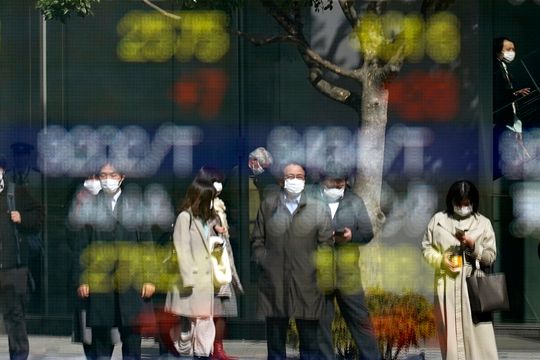TOKYO — Asian shares were mixed Monday, shaken by a Wall Street tumble that set off worries the biggest U.S. bank failure in nearly 15 years might have ripple effects around the world.
But the falls were relatively subdued because of reassurances from U.S. officials that financial shocks would be mitigated.
Japan’s benchmark Nikkei 225 JP:NIK slipped 1.6% in morning trading. Australia’s S&P/ASX 200 AU:XJO slipped 0.2% and South Korea’s Kospi KR:180721 inched up 0.2%.
Hong Kong’s Hang Seng HK:HSI rose 1.6% and the Shanghai Composite CN:SHCOMP edged up 0.6%. Benchmark indexes in Singapore SG:STI, Taiwan TW:Y9999 and Indonesia ID:JAKIDX slumped.
The recent developments in Chinese politics have also worked as a stabilizing factor. Major posts, including the governor of the Bank of China, as well as other political leaders, were announced, signaling a continuation of policy.
Before trading began in Asia, the U.S. Treasury Department, Federal Reserve and FDIC said Sunday that all Silicon Valley Bank clients will be protected and have access to their funds and announced steps designed to protect the bank’s customers and prevent more bank runs.
Regulators closed Silicon Valley Bank SIVB on Friday amid a run on the bank, which was the second-largest U.S. bank failure, behind the 2008 failure of Washington Mutual. They also announced Sunday that New York-based Signature Bank was being seized after it became the third-largest bank failure in U.S. history.
Following two bank failures, worries about financial stability and liquidity concerns were dominating the market landscape, said Stephen Innes, managing partner at SPI Asset Management in Hong Kong.
He said traders made nervous by the weekend’s news could create “a ready-aim-fire Monday open.”
“With the market likely headed for a more turbulent period with US inflation on a collision course with Bank ‘theater of tragedy,’ now is probably not the best time for investor euphoria,” Innes said.
But the sense that U.S. authorities were taking some steps to limit “the contagion effect” had somewhat of a calming effect, although “markets remain skittish” in Asia, said Venkateswaran Lavanya at Mizuho Bank.
Shares tanked Friday on Wall Street, with the S&P 500 dropping 1.4% to cap its worst week since September.
The Dow Jones Industrial Average DJIA fell 345 points, or 1.1%, while the Nasdaq composite COMP sank 1.8%. The S&P 500 SPX fell 56.73 points to 3,861.59. The Dow lost 345.22 to 31,909.64, and the Nasdaq dropped 199.47 to 11,138.89.
Some of the sharpest drops on Wall Street last week came from the financial industry. First Republic Bank FRC tumbled 14.8%, while Charles Schwab SCHW lost another 11.7% after dropping 12.8% Thursday. Larger banks, which have been stress-tested by regulators following the 2008 financial crisis, held up better. JPMorgan Chase JPM rose 2.5%.
In Tokyo trading, banking issues were sold, with MUFG Bank JP:8306 falling 3% before recovering to about a 1% fall, echoing such falls on Wall Street.
Worries were growing recently that interest rates are set to go higher than expected after the Fed Reserve said it could reaccelerate the size of its rate hikes. The Fed is focusing on wage growth in particular in its fight against inflation. It worries too-high gains could cause a vicious cycle that worsens inflation.
Traders now largely expect the Fed to stick with a modest 0.25 point hike. Last month, the Fed slowed to that pace after earlier hiking by 0.50 and 0.75 points. The Fed has already raised rates at the fastest pace in decades and made other moves to reverse its tremendous support for the economy during the pandemic.
In energy trading, benchmark U.S. crude CLJ23 rose 48 cents to $77.08 a barrel. Brent crude BRNK23, the international standard, rose 48 cents to $83.15 a barrel.
In currency trading, the U.S. dollar USDJPY fell to 134.36 Japanese yen from 134.96 yen.

